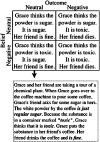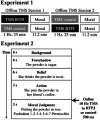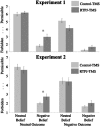Disruption of the right temporoparietal junction with transcranial magnetic stimulation reduces the role of beliefs in moral judgments - PubMed (original) (raw)
Disruption of the right temporoparietal junction with transcranial magnetic stimulation reduces the role of beliefs in moral judgments
Liane Young et al. Proc Natl Acad Sci U S A. 2010.
Abstract
When we judge an action as morally right or wrong, we rely on our capacity to infer the actor's mental states (e.g., beliefs, intentions). Here, we test the hypothesis that the right temporoparietal junction (RTPJ), an area involved in mental state reasoning, is necessary for making moral judgments. In two experiments, we used transcranial magnetic stimulation (TMS) to disrupt neural activity in the RTPJ transiently before moral judgment (experiment 1, offline stimulation) and during moral judgment (experiment 2, online stimulation). In both experiments, TMS to the RTPJ led participants to rely less on the actor's mental states. A particularly striking effect occurred for attempted harms (e.g., actors who intended but failed to do harm): Relative to TMS to a control site, TMS to the RTPJ caused participants to judge attempted harms as less morally forbidden and more morally permissible. Thus, interfering with activity in the RTPJ disrupts the capacity to use mental states in moral judgment, especially in the case of attempted harms.
Conflict of interest statement
The authors declare no conflict of interest.
Figures
Fig. 1.
Experimental stimuli and design. (Upper) Combination of belief (neutral vs. negative) and outcome (neutral vs. negative) factors yielded a 2 × 2 design with four conditions. (Lower) Text of a sample “attempted harm” scenario. Bold italicized sections indicate words that differed across conditions.
Fig. 2.
Design for experiment 1 (Upper) and experiment 2 (Lower). Experiment 1 used an offline TMS paradigm in which participants received TMS at 1 Hz for 25 min and then read and responded to a series of moral scenarios. The order of TMS sessions, RTPJ first vs. control first, was counterbalanced across participants. Experiment 2 used an online TMS paradigm in which participants received TMS at 10 Hz for 500 ms. TMS onset was concurrent with onset of the moral judgment question for each story.
Fig. 3.
Results for experiment 1 (Upper) and experiment 2 (Lower). Moral judgments were made on a seven-point scale. Light bars correspond to control TMS, and dark bars correspond to RTPJ TMS. Bars represent SEM. Moral judgments of attempted harm (negative belief, neutral outcome) are significantly different by TMS site (RTPJ vs. control; *P < 0.05).
Similar articles
- Disruption on right temporoparietal junction with transcranial magnetic stimulation affects moral judgment: No difference between first- and third-personal narration with TMS.
Chou Y, Chen TY. Chou Y, et al. Neuropsychologia. 2021 Jul 16;157:107858. doi: 10.1016/j.neuropsychologia.2021.107858. Epub 2021 Apr 20. Neuropsychologia. 2021. PMID: 33857530 - Modulation of Neural Activity in the Temporoparietal Junction with Transcranial Direct Current Stimulation Changes the Role of Beliefs in Moral Judgment.
Ye H, Chen S, Huang D, Zheng H, Jia Y, Luo J. Ye H, et al. Front Hum Neurosci. 2015 Dec 14;9:659. doi: 10.3389/fnhum.2015.00659. eCollection 2015. Front Hum Neurosci. 2015. PMID: 26696868 Free PMC article. - Increasing the role of belief information in moral judgments by stimulating the right temporoparietal junction.
Sellaro R, Güroǧlu B, Nitsche MA, van den Wildenberg WP, Massaro V, Durieux J, Hommel B, Colzato LS. Sellaro R, et al. Neuropsychologia. 2015 Oct;77:400-8. doi: 10.1016/j.neuropsychologia.2015.09.016. Epub 2015 Sep 13. Neuropsychologia. 2015. PMID: 26375450 - Decoding moral judgments from neural representations of intentions.
Koster-Hale J, Saxe R, Dungan J, Young LL. Koster-Hale J, et al. Proc Natl Acad Sci U S A. 2013 Apr 2;110(14):5648-53. doi: 10.1073/pnas.1207992110. Epub 2013 Mar 11. Proc Natl Acad Sci U S A. 2013. PMID: 23479657 Free PMC article. - Disruption of the Right Temporoparietal Junction Impairs Probabilistic Belief Updating.
Mengotti P, Dombert PL, Fink GR, Vossel S. Mengotti P, et al. J Neurosci. 2017 May 31;37(22):5419-5428. doi: 10.1523/JNEUROSCI.3683-16.2017. Epub 2017 May 4. J Neurosci. 2017. PMID: 28473647 Free PMC article.
Cited by
- The price of your soul: neural evidence for the non-utilitarian representation of sacred values.
Berns GS, Bell E, Capra CM, Prietula MJ, Moore S, Anderson B, Ginges J, Atran S. Berns GS, et al. Philos Trans R Soc Lond B Biol Sci. 2012 Mar 5;367(1589):754-62. doi: 10.1098/rstb.2011.0262. Philos Trans R Soc Lond B Biol Sci. 2012. PMID: 22271790 Free PMC article. - Characterization of the temporo-parietal junction by combining data-driven parcellation, complementary connectivity analyses, and functional decoding.
Bzdok D, Langner R, Schilbach L, Jakobs O, Roski C, Caspers S, Laird AR, Fox PT, Zilles K, Eickhoff SB. Bzdok D, et al. Neuroimage. 2013 Nov 1;81:381-392. doi: 10.1016/j.neuroimage.2013.05.046. Epub 2013 May 17. Neuroimage. 2013. PMID: 23689016 Free PMC article. - Moral Judgments Depend on Information Presentation: Evidence for Recency and Transfer Effects.
Leloup L, Meert G, Samson D. Leloup L, et al. Psychol Belg. 2018 Sep 27;58(1):256-275. doi: 10.5334/pb.421. Psychol Belg. 2018. PMID: 30479821 Free PMC article. - Age differences in specific neural connections within the Default Mode Network underlie theory of mind.
Hughes C, Cassidy BS, Faskowitz J, Avena-Koenigsberger A, Sporns O, Krendl AC. Hughes C, et al. Neuroimage. 2019 May 1;191:269-277. doi: 10.1016/j.neuroimage.2019.02.024. Epub 2019 Feb 19. Neuroimage. 2019. PMID: 30794869 Free PMC article. - How and where: theory-of-mind in the brain.
Mahy CE, Moses LJ, Pfeifer JH. Mahy CE, et al. Dev Cogn Neurosci. 2014 Jul;9:68-81. doi: 10.1016/j.dcn.2014.01.002. Epub 2014 Jan 25. Dev Cogn Neurosci. 2014. PMID: 24552989 Free PMC article. Review.
References
- Baird JA, Astington JW. The role of mental state understanding in the development of moral cognition and moral action. New Dir Child Adolesc Dev. 2004;103:37–49. - PubMed
- Karniol R. Children's use of intention cues in evaluating behavior. Psychol Bull. 1978;85:76–85.
- Piaget J. The Moral Judgment of the Child. New York: Free Press; 1932.
- Gallagher HL, Frith CD. Functional imaging of ‘theory of mind’. Trends Cogn Sci. 2003;7:77–83. - PubMed
- Gobbini MI, Koralek AC, Bryan RE, Montgomery KJ, Haxby JV. Two takes on the social brain: A comparison of theory of mind tasks. J Cognit Neurosci. 2007;19:1803–1814. - PubMed
Publication types
MeSH terms
Grants and funding
- R25 MH094612/MH/NIMH NIH HHS/United States
- P41 RR014075/RR/NCRR NIH HHS/United States
- P41RR14075/RR/NCRR NIH HHS/United States
- UL1 RR025758/RR/NCRR NIH HHS/United States
- K 24 RR018875/RR/NCRR NIH HHS/United States
LinkOut - more resources
Full Text Sources
Other Literature Sources
Medical


